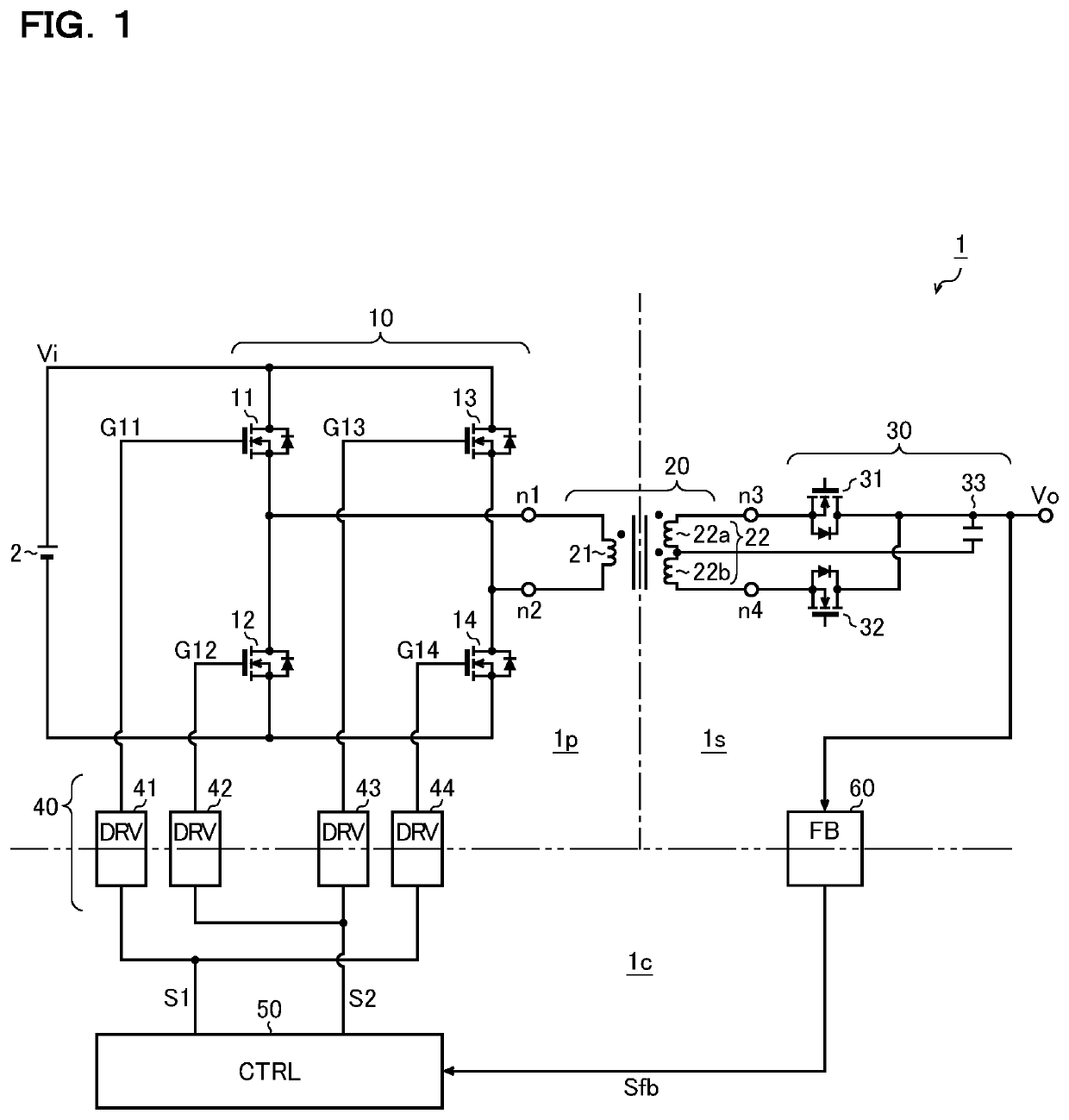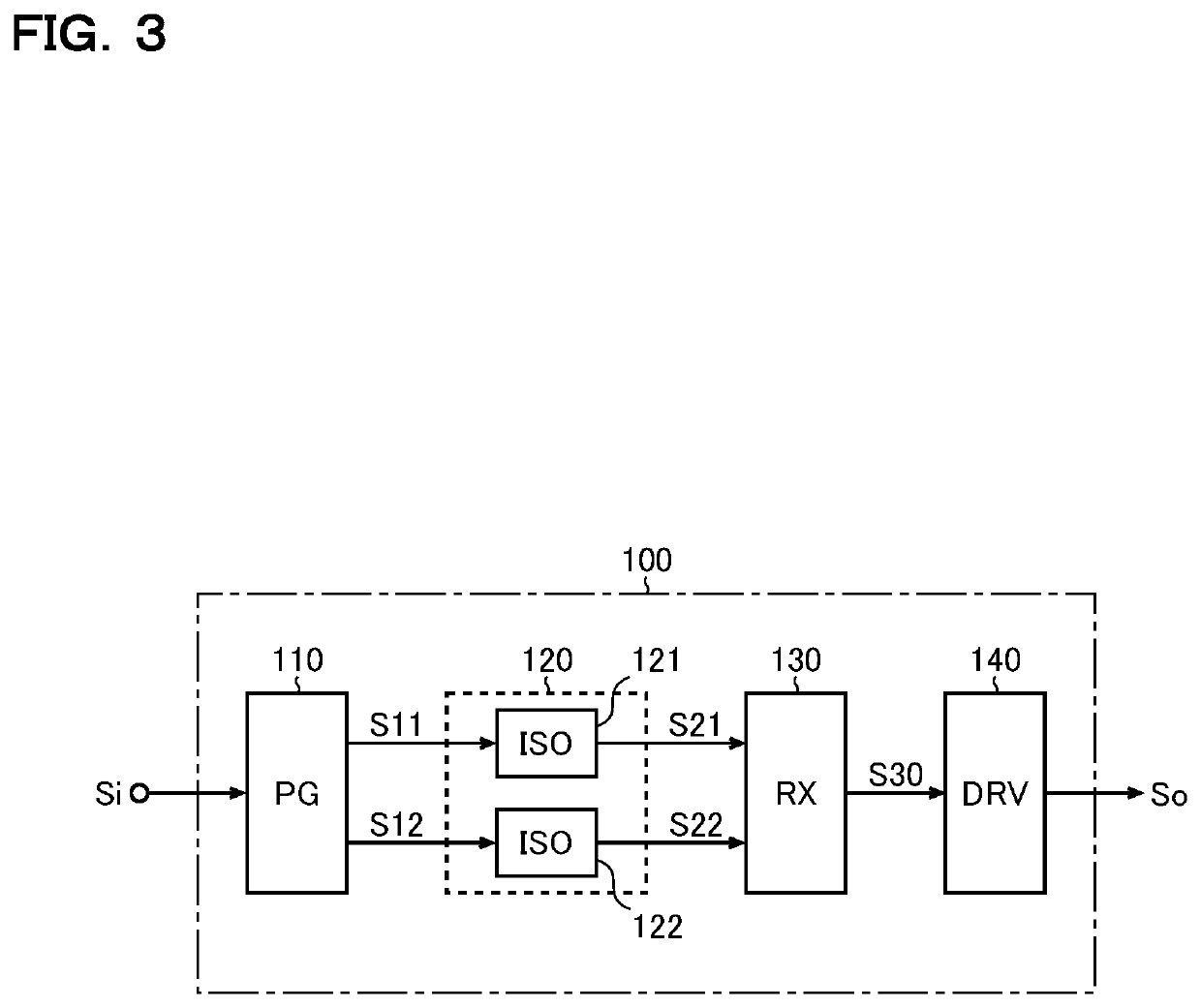Signal transfer device
a signal transfer and signal technology, applied in the direction of generating/distributing signals, multiple input and output pulse circuits, electric pulse generator details, etc., can solve the problems of reducing signal delay, conventional signal transfer devices leave room for improvement in terms, and conventional signal transfer devices leave room for improvement, so as to reduce signal delay and fast noise cancellation
- Summary
- Abstract
- Description
- Claims
- Application Information
AI Technical Summary
Benefits of technology
Problems solved by technology
Method used
Image
Examples
first embodiment
Signal Transfer Device (First Embodiment)
[0066]FIG. 3 is a diagram showing a first embodiment of a signal transfer device that can be used as, for example, the isolated gate drivers 41 to 44. The signal transfer device 100 of this embodiment includes a pulse generation circuit 110, an isolation circuit 120, a pulse reception circuit 130, and an output drive circuit 140.
[0067]The pulse generation circuit 110 generates transmission pulse signals S11 and S12 according to an input signal Si. More specifically, the pulse generation circuit 110, when notifying that the input signal Si is at high level, pulse-drives the transmission pulse signal S11 (outputs as the transmission pulse signal S11 a single pulse or several pulses) and, when notifying that the input signal Si is at low level, pulse-drives the transmission pulse signal S12 (outputs as the transmission pulse signal S12 a single pulse or several pulses). That is, the pulse generation circuit 110 pulse-drives one of the transmissi...
second embodiment
Signal Transfer Device (Second Embodiment)
[0101]FIG. 7 is a diagram showing a second embodiment of the signal transfer device 100. The signal transfer device 100 of this embodiment, while being based on the first embodiment (FIG. 3) described previously, has the pulse generation circuit 110, the isolation circuit 120, and the pulse reception circuit 130 implemented with specific circuit configurations respectively as a means for achieving signal transfer in a multiple transmission-reception system. It should be noted that such a signal transfer device 100 for a multiple transmission-reception system does not necessarily presuppose application to the isolated gate drivers 41 to 44.
[0102]Moreover, in the signal transfer device 100 of this embodiment, a noise cancel circuit 150 is provided between the isolation circuit 120 and the pulse reception circuit 130. In the diagram, the output drive circuit 140 is omitted from illustration, and whether to include or omit it is of free choice. ...
third embodiment
Signal Transfer Device (Third Embodiment)
[0155]FIG. 11 is a diagram showing a third embodiment of the signal transfer device 100. The signal transfer device 100 of this embodiment, while being based on the second embodiment (FIG. 7) described previously, uses, as the reset signal RSTH, not the logically inverted signal of the mask signal MSKH, but the logically inverted signal of the clock signal CLKL, and uses, as the reset signal RSTL, not the logically inverted signal of the mask signal MSKL, but the logically inverted signal of the clock signal CLKH.
[0156]Specifically, when a pulse is generated in the clock signal CLKL, the count value CNTH of the counter 132 is set back to the initial value (=0); when a pulse is generated in the clock signal CLKH, the count value CNTL of the counter 133 is set back to the initial value (=0).
[0157]As mentioned previously, even when in-phase noise occurs in both the input signals INH and INL, owing to the action of the noise cancel circuit 150, n...
PUM
 Login to View More
Login to View More Abstract
Description
Claims
Application Information
 Login to View More
Login to View More - R&D
- Intellectual Property
- Life Sciences
- Materials
- Tech Scout
- Unparalleled Data Quality
- Higher Quality Content
- 60% Fewer Hallucinations
Browse by: Latest US Patents, China's latest patents, Technical Efficacy Thesaurus, Application Domain, Technology Topic, Popular Technical Reports.
© 2025 PatSnap. All rights reserved.Legal|Privacy policy|Modern Slavery Act Transparency Statement|Sitemap|About US| Contact US: help@patsnap.com



